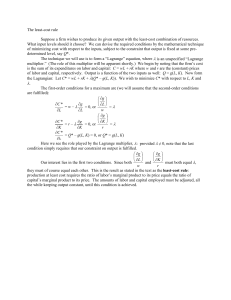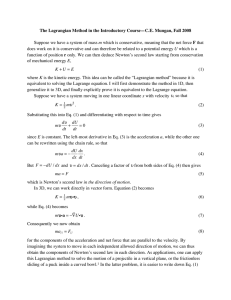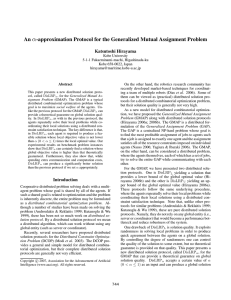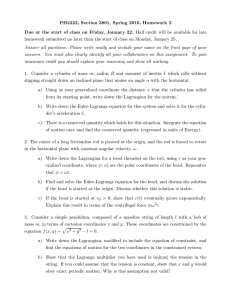A New Approach to Distributed Task Assignment using
advertisement
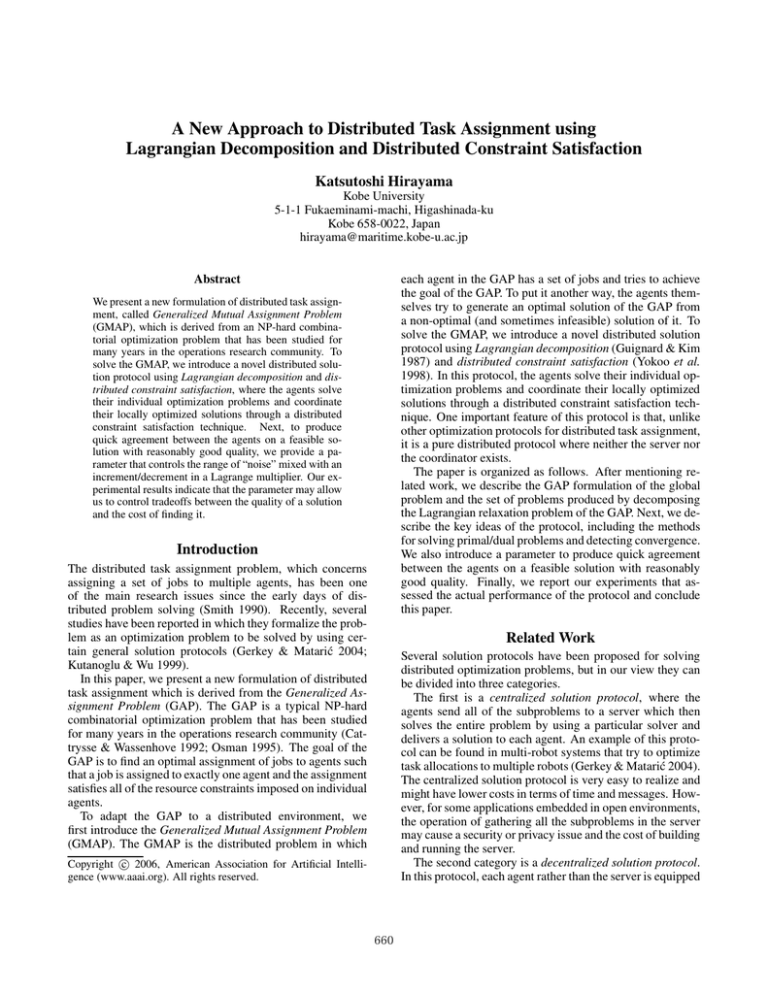
A New Approach to Distributed Task Assignment using
Lagrangian Decomposition and Distributed Constraint Satisfaction
Katsutoshi Hirayama
Kobe University
5-1-1 Fukaeminami-machi, Higashinada-ku
Kobe 658-0022, Japan
hirayama@maritime.kobe-u.ac.jp
Abstract
each agent in the GAP has a set of jobs and tries to achieve
the goal of the GAP. To put it another way, the agents themselves try to generate an optimal solution of the GAP from
a non-optimal (and sometimes infeasible) solution of it. To
solve the GMAP, we introduce a novel distributed solution
protocol using Lagrangian decomposition (Guignard & Kim
1987) and distributed constraint satisfaction (Yokoo et al.
1998). In this protocol, the agents solve their individual optimization problems and coordinate their locally optimized
solutions through a distributed constraint satisfaction technique. One important feature of this protocol is that, unlike
other optimization protocols for distributed task assignment,
it is a pure distributed protocol where neither the server nor
the coordinator exists.
The paper is organized as follows. After mentioning related work, we describe the GAP formulation of the global
problem and the set of problems produced by decomposing
the Lagrangian relaxation problem of the GAP. Next, we describe the key ideas of the protocol, including the methods
for solving primal/dual problems and detecting convergence.
We also introduce a parameter to produce quick agreement
between the agents on a feasible solution with reasonably
good quality. Finally, we report our experiments that assessed the actual performance of the protocol and conclude
this paper.
We present a new formulation of distributed task assignment, called Generalized Mutual Assignment Problem
(GMAP), which is derived from an NP-hard combinatorial optimization problem that has been studied for
many years in the operations research community. To
solve the GMAP, we introduce a novel distributed solution protocol using Lagrangian decomposition and distributed constraint satisfaction, where the agents solve
their individual optimization problems and coordinate
their locally optimized solutions through a distributed
constraint satisfaction technique. Next, to produce
quick agreement between the agents on a feasible solution with reasonably good quality, we provide a parameter that controls the range of “noise” mixed with an
increment/decrement in a Lagrange multiplier. Our experimental results indicate that the parameter may allow
us to control tradeoffs between the quality of a solution
and the cost of finding it.
Introduction
The distributed task assignment problem, which concerns
assigning a set of jobs to multiple agents, has been one
of the main research issues since the early days of distributed problem solving (Smith 1990). Recently, several
studies have been reported in which they formalize the problem as an optimization problem to be solved by using certain general solution protocols (Gerkey & Matarić 2004;
Kutanoglu & Wu 1999).
In this paper, we present a new formulation of distributed
task assignment which is derived from the Generalized Assignment Problem (GAP). The GAP is a typical NP-hard
combinatorial optimization problem that has been studied
for many years in the operations research community (Cattrysse & Wassenhove 1992; Osman 1995). The goal of the
GAP is to find an optimal assignment of jobs to agents such
that a job is assigned to exactly one agent and the assignment
satisfies all of the resource constraints imposed on individual
agents.
To adapt the GAP to a distributed environment, we
first introduce the Generalized Mutual Assignment Problem
(GMAP). The GMAP is the distributed problem in which
Related Work
Several solution protocols have been proposed for solving
distributed optimization problems, but in our view they can
be divided into three categories.
The first is a centralized solution protocol, where the
agents send all of the subproblems to a server which then
solves the entire problem by using a particular solver and
delivers a solution to each agent. An example of this protocol can be found in multi-robot systems that try to optimize
task allocations to multiple robots (Gerkey & Matarić 2004).
The centralized solution protocol is very easy to realize and
might have lower costs in terms of time and messages. However, for some applications embedded in open environments,
the operation of gathering all the subproblems in the server
may cause a security or privacy issue and the cost of building
and running the server.
The second category is a decentralized solution protocol.
In this protocol, each agent rather than the server is equipped
c 2006, American Association for Artificial IntelliCopyright gence (www.aaai.org). All rights reserved.
660
job is assigned or not assigned to an agent (denoted as 01
constraints). We refer to the maximal total sum of profits
as the optimal value and the assignment that provides the
optimal value as the optimal solution.
We obtain the following Lagrangian relaxation problem
LGAP(µ) by dualizing the assignment constraints of GAP
(Fisher 1981).
with a solver and the server plays the role of a coordinator to
facilitate communication among the agents. An example of
this protocol can be found in distributed scheduling. For example, Kutanoglu and Wu have presented an auction-based
protocol for the resource scheduling problem, in which the
agents solve the problem in a distributed fashion under the
coordination of the auctioneer (Kutanoglu & Wu 1999).
Similar approaches have been proposed for the nonlinear
programming problem (Androulakis & Reklaitis 1999) and
the supply-chain optimization problem (Nishi, Konishi, &
Hasebe 2005). Although the decentralized solution protocol allows the agents to keep their subproblems private, the
server can obtain all of the information on solving processes
whereby the server may guess the entire problem. Furthermore, the protocol still needs a server that requires tedious
maintenance.
The third category is a distributed solution protocol. Unlike the other protocols, this protocol does not need a server
because the agents themselves try to solve the entire problem through peer-to-peer local communication. It is noteworthy that with this protocol, every agent knows neither
what the entire problem is nor how the entire solving processes are run. Recently, this type of protocol has been
proposed for solving the distributed partial constraint satisfaction problem (Hirayama & Yokoo 1997) and the distributed constraint optimization problem (Modi et al. 2003;
Petcu & Faltings 2005). We believe that it is a promising
direction for distributed problem solving because it is well
suited to optimization tasks in open environments.
LGAP(µ)
max.
k∈A j∈J
s. t.
max.
LGMP k (µ)
max.
s. t.
xkj = 1, ∀j ∈ J,
(1)
wkj xkj ≤ ck , ∀k ∈ A,
(2)
xkj ∈ {0, 1}, ∀k ∈ A, ∀j ∈ J,
(3)
k∈A
j∈J
k∈A
wkj xkj ≤ ck , ∀k ∈ A,
where µj is a real-valued parameter called a Lagrange multiplier for (the assignment constraint of) job j. Note that
the vector µ = (µ1 , µ2 , . . . , µn ) is called a Lagrange multiplier vector. Based on the idea of Lagrangian decomposition
(Guignard & Kim 1987), we can divide this problem into a
set of subproblems {LGMP k (µ)|k ∈ A}, where each subproblem LGMP k (µ) of agent k is as follows.
(decide xkj , ∀j ∈ Rk ) :
1
− xkj
pkj xkj +
µj
|Sj |
j∈Rk
j∈Rk
wkj xkj ≤ ck ,
j∈Rk
xkj ∈ {0, 1}, ∀j ∈ Rk ,
where Rk is a set of jobs that may be assigned to agent k
and Sj is a set of agents to whom job j may be assigned.
We can assume that Sj = ∅ because a job with an empty
Sj does not have to be considered in the problem. When we
consider that agent k decides the value of xkj for ∀j ∈ Rk
(in other words, the agent that may be assigned job j has
a right to decide whether it will undertake the job or not),
agent k is able to solve LGMP k (µ) completely by itself
since LGMP k (µ) includes only k’s decision variables.
Regarding the relation between the entire problem and a
set of subproblems, the following properties are very useful
in designing a distributed solution protocol for the GMAP.
k∈A j∈J
s. t.
j∈J
xkj ∈ {0, 1}, ∀k ∈ A, ∀j ∈ J,
A GMAP instance consists of multiple agents each having
a finite set of jobs that are to be assigned. The agents as
a whole solve the following integer programming problem,
denoted as GAP.
(decide xkj , ∀k ∈ A, ∀j ∈ J) :
pkj xkj
j∈J
Formalization
GAP
(decide xkj , ∀k ∈ A, ∀j ∈ J) :
pkj xkj +
µj 1 −
xkj
Property 1 For any value of µ, the total sum of the optimal
values of {LGMP k (µ)|k ∈ A} provides an upper bound of
the optimal value of GAP.
where A = {1, ..., m} is a set of agents; J = {1, ..., n}
is a set of jobs; pkj and wkj are the profit and amount of
resource required, respectively, when agent k selects job j;
ck is the capacity, i.e., the amount of available resource, of
agent k. xkj is a decision variable whose value is set to 1
when agent k selects job j and 0 otherwise. The goal of the
agents is to find a job assignment that maximizes the total
sum of profits such that (1) each job is assigned to exactly
one agent (denoted as assignment constraints), (2) the total
amount of resource required for each agent does not exceed
its capacity (denoted as knapsack constraints), and (3) each
Property 2 For any value of µ, if all of the optimal solutions
to {LGMP k (µ)|k ∈ A} satisfy the assignment constraints,
i∈A xij = 1, ∀j ∈ J, then these optimal solutions constitute an optimal solution to GAP.
Protocol
Property 2 prompted the development of a distributed solution protocol, called the distributed Lagrangian relaxation protocol, where the agents start with t = 0 and
661
µ(0) = (0, . . . , 0) and alternate the following series of actions (called a round) in parallel until all of the assignment
constraints are satisfied.
1. Each agent k finds an optimal solution to LGMP k (µ(t) )
(solves the primal problem).
2. Agents exchange these solutions with their neighboring
agents.
3. Each agent k updates the Lagrange multiplier vector from
µ(t) to µ(t+1) (solves the dual problem) and increases t
by one.
It must be noted that the overall behavior of this protocol is
similar to the distributed breakout algorithm for solving the
DisCSP (Hirayama & Yokoo 2005). We describe the key
ideas and details of the protocol in this section.
the related decision variables, agent k first computes subgradient gj for an assignment constraint of each job j ∈ Rk as
follows:
gj = 1 −
xij .
i∈Sj
Basically, gj provides an updating direction of µj by taking
a positive integer when no agent in Sj currently selects job j,
a negative integer when two or more agents in Sj currently
select that job, and zero when exactly one agent currently
selects it. Then, using |Sj | and step length l(t) , which may
decay at rate r (0 < r ≤ 1) as the number of rounds t increases (i.e., l(t+1) ← rl(t) ), agent k updates the multiplier
of job j as
gj
(t+1)
(t)
.
(4)
µj
← µj − l(t)
|Sj |
The idea behind this updating rule is simple. A multiplier of
a job becomes higher when the job invites too many agents
and lower when the job invites too few agents. In this sense,
µj can be viewed as the price of job j. Note that the degree of update depends on both the step length decaying at
rate r and what percentage of the potentially involved agents
should be encouraged/discouraged to select that job.
Notice that since µj is attached to job j, all of the agents
in Sj must agree on a common value for it. If the agents
in Sj assign different values to µj , neither property 1 nor 2
holds any more. To set such a common value, we give all of
the agents a common initial value for µ, a common value for
the initial step length l(0) , and a common value for the decay
rate r as their prior knowledge, and prohibit each agent from
working in round t + 1 until it receives all of the assign messages issued from its neighbors in round t. By doing this,
instead of implementing explicit communication among Sj ,
we can force agents to automatically set a common value as
a Lagrange multiplier.
Neighborhood and Communication Model
In order to solve the primal and dual problems, agent k
(t)
needs, for each job j in Rk , the values of µj , the size
of Sj , and the decision variables of the related agents (i.e.,
(t)
{xij | i ∈ Sj , i = k}). The value of µj is locally computed
as we will explain later, and the size of Sj is given to agent
k as prior knowledge. On the other hand, the values of the
decision variables are obtained
through communication with
each agent in a set denoted as j∈Rk Sj \ {k}. We refer to
this set of agents as agent k’s neighbors and allow an agent
to communicate only with its neighbors. Thus, the protocol
assumes a peer-to-peer message exchange model, in which
a message is never lost and, for any pair of agents, messages
are received in the order in which they were sent.
Primal Problem
Once agent k decides the values of the associated Lagrange multipliers, it searches for an optimal solution to
LGMP k (µ(t) ) to determine the values of its own decision
variables {xkj | j ∈ Rk }. This search problem is equivalent to the knapsack problem whose goal is to select the
most profitable subset of Rk such that the total resource requirement of the subset does not exceed ck . In the problem,
(t)
for each job j in Rk , the profit is pkj − µj , and the resource requirement is wkj . Since the knapsack problem is
an NP-hard problem, we cannot expect, in principle, an efficient exact solution method. However, recent attempts at
exact solution methods for the knapsack problem have been
so remarkable that they can readily solve even a very large
instance in many cases (Martello, Pisinger, & Toth 2000).
After finding an optimal solution, agent k sends the solution (along with other information explained later) to its
neighbors via an assign message.
Convergence Detection
The protocol should be terminated when all of the optimal
solutions to {LGMP k (µ(t) ) | k ∈ A} satisfy all of the assignment constraints, but it is not so simple to detect this
fact because no agent knows the entire solving processes.
The protocol uses a termination detection procedure of the
distributed breakout algorithm (Hirayama & Yokoo 2005) to
detect this fact, which is summarized as follows.
Agent k has a boolean variable csk and a non-negative
integer variable tck (initialized by zero). Intuitively, csk
represents whether the assignment constraints of agent k is
locally satisfied while tck represents how far from agent k
that all of their respective assignment constraints are satisfied. Agent k sends csk and tck to its neighbors via an assign message together with its current solution. Suppose that
agent k receives all of the assign messages from its neighbors. It cannow determine whether all of its assignment
constraints, i∈Sj xij = 1, ∀j ∈ Rk , are satisfied. Thus, it
sets csk as true if they are satisfied and false otherwise. On
the other hand, if its csk becomes true and all of the received
css are true, it identifies a minimum value over k’s and its
neighbors’ tcs and sets tck as the minimum value plus one;
otherwise, it sets tck to zero. In the above, if the value of tck
Dual Problem
After receiving all of the current solutions of neighbors,
agent k solves the dual problem, whose goal is to minimize
an upper bound of the optimal value of GAP, by updating the related Lagrange multipliers. Here, we used a subgradient optimization method, which is a well-known technique for systematically updating a Lagrange multiplier vector (Fisher 1981). In the method, using the current values of
662
procedure init
1. round k := 1;
2. cs k := false;
3. tc k := 0;
4. leng := someCommonValue;
5. r := someCommonRatio;
6. δ := someCommonRatio;
7. cutOffRound := someCommonValue;
8. for each job j ∈ Rk do µj := 0 end do;
9. Jobs k := optimal solution to knapsack problem;
10. send assign(k, round k , cs k , tc k , Jobs k ) to neighbors;
11. WaitL := neighbors;
12. cs N := true;
procedure localcomp
1. round k := round k + 1;
2. leng := leng ∗ r;
3. if round k > cutOffRound then
4.
return true;
5. else
6.
cs k := true;
7.
for each job j ∈ Rk do
8.
calculate subgradient gj based on AgentView ;
9.
if gj = 0 then
10.
cs k := false;
11.
:= randomly chosen value from [−δ, δ];
12.
µj := µj − (1 + ) ∗ leng ∗ gj /|Sj |;
13.
end if ;
14.
end do;
15.
if cs k ∧ cs N then
16.
tc k := tc k + 1;
17.
if tc k = #agents then return true end if ;
18.
else
19.
tc k := 0;
20.
Jobs k := optimal solution to knapsack problem;
21.
end if ;
22.
send assign(k, round k , cs k , tc k , Jobs k ) to neighbors;
23.
return false;
24. end if ;
Figure 1: Distributed Lagrangian relaxation protocol: init
procedure
when k receives assign(i, round i , cs i , tc i , Jobs i ) from i do
1. if round k < round i then
2.
add this message in DeferredL;
3. else
4.
if cs i then
5.
tc k := min(tc k , tc i );
6.
else
7.
cs N := false;
8.
update AgentView with Jobs i ;
9.
end if ;
10.
delete i from WaitL;
11.
if WaitL is empty then
12.
stop := localcomp;
13.
if stop then
14.
terminate the procedure;
15.
else
16.
WaitL := neighbors;
17.
cs N := true;
18.
restore each message in DeferredL to process;
19.
end if ;
20.
end if ;
21. end if ;
end do
Figure 3: Distributed Lagrangian relaxation protocol: localcomp procedure
value is uniformly distributed over [−δ, δ]. The multiplier
updating rule (4) is thus replaced by
gj
(t+1)
(t)
µj
.
(5)
← µj − (1 + Nδ )l(t)
|Sj |
This rule diversifies the agents’ views on the value of µj (the
price of job j) and thus the protocol can break an infinite
loop. On the other hand, since properties 1 and 2 do not
hold anymore under this rule, the protocol may converge to
a non-optimal (but feasible) solution. Note that rule (5) is
equal to rule (4) if δ is set to zero.
All of these ideas are merged into a series of procedures
described in Figs. 1–3.
Figure 2: Distributed Lagrangian relaxation protocol: message processing procedure
reaches the diameter of the communication network, whose
nodes represent agents and links represent neighborhood relationships between pairs of agents, all of the assignment
constraints are satisfied. Note that the diameter can be replaced by the number of agents, which is an upper bound of
the diameter.
Experiments
Through experiments, we assessed the performance of the
protocol when varying the values of δ and the assignment
topologies. We chose two problem suites, a hand-made one
that had various assignment topologies and the other from
the GAP benchmark instances of OR-Library1 , which had a
specific assignment topology.
The first problem suite includes instances in which there
exist m ∈ {5, 7} agents (numbered from 1 to m), each of
which has 5 jobs, meaning that the total number of jobs n
was 5m, and tries to assign each of its jobs to some agent
(that may be itself) by using one of the following assignment
topologies:
chain The ith agent (i ∈ {2, . . . , m − 1}) tries to assign
each of its jobs to the (i−1)th agent, the (i+1)th agent, or
itself. On the other hand, the 1st agent tries to assign each
of its jobs to either the 2nd agent or itself while the mth
agent tries to assign each of its jobs to either the (m−1)th
agent or itself.
Convergence to a Feasible Solution
Unfortunately, the protocol may be trapped in an infinite
loop depending on the parameter values of rule (4). In that
case, the protocol must be forced to terminate after a certain number of rounds, despite that it has not yet discovered any feasible solution on the way to an optimal solution. Therefore, we make rule (4) stochastic so that the protocol can break an infinite loop and produce quick agreement between the agents on a feasible solution with reasonably good quality. More specifically, we let the agents in
Sj assign slightly different values to µj by introducing a parameter δ (0 ≤ δ ≤ 1) that controls the range of “noise”
mixed with an increment/decrement in the Lagrange multiplier. The noise, denoted as Nδ , is a random variable whose
1
663
http://people.brunel.ac.uk/˜mastjjb/jeb/orlib/gapinfo.html
ring The story is the same as that in the above except that
the 1st agent tries to assign each of its job to the mth
agent, the 2nd agent, or itself while the mth agent tries to
assign each of its job to either the (m − 1)th agent, the 1st
agent, or itself.
Table 1: Experimental results on hand-made problem suite
with various assignment topologies. The Pr.ID column
shows a label of a problem instance that indicates, from left
to right, assignment topology, number of agents, total number of jobs, and instance identifier
cmplt Each agent tries to assign each of its jobs to any of
the agents (including itself).
Pr.ID
δ
chain- 0.0
525-0 0.3
1.0
chain- 0.0
525-1 0.3
1.0
ring- 0.0
525-0 0.3
1.0
ring- 0.0
525-1 0.3
1.0
cmplt- 0.0
525-0 0.3
1.0
cmplt- 0.0
525-1 0.3
1.0
rndm- 0.0
525-0 0.3
1.0
rndm- 0.0
525-1 0.3
1.0
rndm Each agent tries to assign each of its jobs to any of the
three agents, two of which are randomly selected from the
other agents for each job and the other is itself.
Note that this yields GMAP instances by considering the
agent who receives a job offer decides whether it will do
the job or not. For a set of m agents with one of the above
assignment topologies, a random instance was made by randomly selecting an integer value from [1, 10] for both the resource requirement wij and profit pij . We fixed the available
resource capacity ci to 20 for any agent i in every instance.
To ensure that all of the problem instances were feasible, we
pre-checked the generated instances with a centralized exact
solver and screened out the infeasible ones.
Regarding the second problem suite, the instances of ORLibrary were originally designed as GAP instances and do
not include any topological information among agents. We
therefore assume a complete topology (cmplt in the above)
among agents and translate a GAP instance into a GMAP
instance. It is worth noting that the GMAP with a complete
topology is equivalent to a problem in which agents search
for an optimal partition of public jobs that does not violate
their individual knapsack constraints.
The protocol was implemented in Java. The agents in the
protocol solved knapsack problem instances using a branchand-bound algorithm with LP bounds and were able to exchange messages using TCP/IP socket communication on
specific ports. In the experiments, we put m agents in
one machine and let them communicate using their local
ports. The parameters for the protocol were fixed as follows:
cutOffRound = 100n, l(0) = 1.0, and r = 1.0, where cutOffRound is the upper bound of rounds at which a run was
forced to terminate, l(0) is an initial value for the step length,
and r is a decay rate of the step length. Parameter δ, which
controls the degree of noise, ranged over {0.0, 0.3, 1.0}. For
each problem instance, 20 runs were made for each value of
δ (except for δ = 0.0) and the following data were measured:
O.R.
0/1
5/20
1/20
0/1
11/20
3/20
0/1
1/20
1/20
0/1
5/20
1/20
0/1
0/20
0/20
0/1
1/20
0/20
0/1
8/20
2/20
0/1
19/20
10/20
F.R.
0/1
20/20
20/20
0/1
20/20
20/20
0/1
19/20
20/20
0/1
20/20
20/20
0/1
20/20
20/20
0/1
20/20
20/20
0/1
20/20
20/20
0/1
20/20
20/20
A.Q.
N/A
0.989
0.964
N/A
0.995
0.985
N/A
0.966
0.957
N/A
0.970
0.939
N/A
0.934
0.881
N/A
0.954
0.908
N/A
0.977
0.951
N/A
0.998
0.957
A.C.
2500
269.6
148.0
2500
84.2
72.4
2500
832.6
362.9
2500
373.6
161.6
2500
423.9
182.5
2500
245.7
111.4
2500
527.3
288.6
2500
40.6
53.8
Pr.ID
δ O.R.
chain- 0.0 0/1
735-0 0.3 3/20
1.0 0/20
chain- 0.0 0/1
735-1 0.3 5/20
1.0 3/20
ring- 0.0 0/1
735-0 0.3 3/20
1.0 0/20
ring- 0.0 0/1
735-1 0.3 1/20
1.0 0/20
cmplt- 0.0 0/1
735-0 0.3 0/20
1.0 0/20
cmplt- 0.0 0/1
735-1 0.3 0/20
1.0 0/20
rndm- 0.0 0/1
735-1 0.3 1/20
1.0 1/20
rndm- 0.0 0/1
735-2 0.3 3/20
1.0 1/20
F.R.
0/1
19/20
19/20
0/1
20/20
20/20
0/1
18/20
20/20
0/1
20/20
20/20
0/1
20/20
20/20
0/1
20/20
20/20
0/1
18/20
18/20
0/1
16/20
20/20
A.Q. A.C.
N/A 3500
0.969 810.7
0.959 473.8
N/A 3500
0.983 359.0
0.966 283.5
N/A 3500
0.959 993.7
0.946 164.0
N/A 3500
0.949 1013.0
0.935 278.3
N/A 3500
0.929 559.3
0.865 151.4
N/A 3500
0.938 488.4
0.883 179.9
N/A 3500
0.971 1213.0
0.951 966.3
N/A 3500
0.967 1507.0
0.916 507.9
δ was 0.0, we made only one run because there was no randomness in the protocol at that setting.
The results are shown in Tables 1 and 2.
As we mentioned, rule (5) is equal to rule (4) when δ is
0.0. The protocol with this setting, therefore, terminates
only when an optimal solution is found (otherwise, it is
forced to terminate when the cutoff round 100n is reached).
However, in the experiments, we observed that the protocol with that setting failed to find optimal solutions within
the cutoff round for all instances of the hand-made problem
suite. A close look at the behavior of agents revealed that
although the agents as a whole could reach a near-optimal
solution (an infeasible solution giving a tight upper bound)
very quickly, they eventually fell into a loop where some
agents clustered and dispersed around a specific set of jobs.
Accordingly, we did not try the protocol with δ = 0.0 for
the instances of the benchmark problem suite.
The performance of the protocol dramatically changed
when δ was set to one of the non-zero values. The results
show that Opt.Ratio, Fes.Ratio, and Avg.Cost are obviously
improved while Avg.Quality is kept at a reasonable level,
suggesting that by using the protocol with those settings, the
agents can quickly agree on a feasible solution with reasonably good quality.
It is also true that the protocol with those settings may
fail to find an optimal solution. In the experiments, it failed
to find an optimal solution at every non-zero value of δ for
Opt.Ratio ratio of the runs where optimal solutions were
found;
Fes.Ratio ratio of the runs where feasible solutions were
found;
Avg.Quality average solution qualities;
Avg.Cost average number of rounds at which feasible solutions were found.
Note that Avg.Quality was measured as the ratio of the profit
of a feasible solution to the optimal value. Note also that,
when a run finished with no feasible solution, we did not
count the run for Avg.Quality, but we did count it using the
value of cutOffRound for Avg.Cost. On the other hand, when
664
non-zero value and adding up the objective values of final
assignments; an upper bound by setting δ to zero and adding
up the objective values of interim assignments. In our future
work, we would like to pursue a distributed method to compute upper bounds for the optimal value and a more sophisticated technique to update the Lagrange multiplier vector.
Table 2: Experimental results on benchmark problem suite
with a complete assignment topology. The Pr.ID column
shows the label of a corresponding instance in the ORLibrary (i.e., in “cmnn-i”, m is number of agents, nn is
total number of jobs, and i is an instance identifier).
Pr.ID
δ
c515-1 0.3
1.0
c520-1 0.3
1.0
c525-1 0.3
1.0
c530-1 0.3
1.0
O.R.
2/10
0/10
2/10
0/10
0/10
0/10
1/10
0/10
F.R.
10/10
10/10
10/10
10/10
10/10
10/10
10/10
10/10
A.Q.
0.993
0.937
0.987
0.955
0.977
0.958
0.979
0.945
A.C.
277.1
222.4
456.2
193.0
605.0
200.2
660.4
202.0
Pr.ID
δ
c824-1 0.3
1.0
c832-1 0.3
1.0
c840-1 0.3
1.0
c848-1 0.3
1.0
O.R.
0/10
0/10
0/10
0/10
0/10
0/10
0/10
0/10
F.R.
10/10
10/10
10/10
10/10
10/10
10/10
10/10
10/10
A.Q. A.C.
0.979 321.8
0.940 149.4
0.977 458.1
0.925 183.7
0.974 653.2
0.934 298.7
0.964 1304.4
0.931 298.8
References
Androulakis, I. P., and Reklaitis, G. V. 1999. Approaches to
asynchronous decentralized decision making. Computers
and Chemical Engineering 23:341–355.
Cattrysse, D. G., and Wassenhove, L. N. V. 1992. A survey of algorithms for the generalized assignment problem.
European J. of Operational Research 60:260–272.
Fisher, M. L. 1981. The Lagrangian relaxation method
for solving integer programming problems. Management
Science 27(1):1–18.
Gerkey, B. P., and Matarić, M. J. 2004. A formal analysis and taxonomy of task allocation in multi-robot systems.
Intl. J. of Robotics Research 23(9):939–954.
Guignard, M., and Kim, S. 1987. Lagrangean decomposition: A model yielding stronger Lagrangean bounds.
Mathematical Programming 39:215–228.
Hirayama, K., and Yokoo, M. 1997. Distributed partial
constraint satisfaction problem. In Proc. 3rd CP, 222–236.
Hirayama, K., and Yokoo, M. 2005. The distributed breakout algorithms. Artificial Intelligence 161(1–2):89–115.
Kutanoglu, E., and Wu, S. D. 1999. On combinatorial
auction and Lagrangian relaxation for distributed resource
scheduling. IIE Transactions 31(9):813–826.
Martello, S.; Pisinger, D.; and Toth, P. 2000. New trends in
exact algorithms for the 0-1 knapsack problem. European
J. of Operational Research 123:325–332.
Modi, P. J.; Shen, W.-M.; Tambe, M.; and Yokoo, M.
2003. An asynchronous complete method for distributed
constraint optimization. In Proc. 2nd AAMAS, 161–168.
Nishi, T.; Konishi, M.; and Hasebe, S. 2005. An autonomous decentralized supply chain planning system for
multi-stage production processes. J. of Intelligent Manufacturing 16:259–275.
Osman, I. H. 1995. Heuristics for the generalised assignment problem: simulated annealing and tabu search approaches. OR Spektrum 17:211–225.
Petcu, A., and Faltings, B. 2005. A scalable method for
multiagent constraint optimization. In Proc. 19th IJCAI,
266–271.
Smith, R. G. 1990. The contract net protocol: high-level
communication and control in a distributed problem solver.
IEEE Trans. on Computers 29(2):1104–1113.
Yokoo, M.; Durfee, E. H.; Ishida, T.; and Kuwabara, K.
1998. The distributed constraint satisfaction problem: formalization and algorithms. IEEE Trans. on Knowledge and
Data Engineering 10(5):673–685.
3 complete topology instances of the hand-made problem
suite (cmplt-525-0, cmplt-735-0, and cmplt-735-1) and 5 instances of the benchmark problem suite. However, for each
of the other instances, an optimal solution was found in at
least one run at some value of δ.
For almost all instances, we can see that when δ increases,
both Avg.Cost and Avg.Quality are reduced. This means
that increasing δ may generally influence the agents to rush
to reach a compromise of lower quality. This indicates that
parameter δ may allow us to control tradeoffs between the
quality of a solution and the cost of finding it.
With these limited number of hand-made problem instances, we cannot say for certain whether the assignment
topologies can affect the performance of the protocol. Our
result, however, clearly shows that the instances with a complete assignment topology ended up with lower quality solutions than those with the other assignment topologies. In
an instance with a complete assignment topology, all of the
agents are involved in each job j and apply rule (5) independently when it is time to update µj . These “noisy” updates
by many agents generally accelerate the diversification of
the agents’ views on multipliers and may force the agents to
rush to reach a compromise of lower quality.
Conclusion
We presented a new formulation of distributed task assignment and a novel distributed solution protocol, whereby the
agents solve their individual optimization problems and coordinate their locally optimized solutions. Furthermore, to
control the performance of the protocol, we introduced a parameter δ that controls the degree of noise mixed with an
increment/decrement in a Lagrange multiplier. Our experimental results showed that if δ is set to a non-zero value, the
agents can quickly agree on feasible solutions with reasonably good quality. The results also indicated that the parameter may allow us to control tradeoffs between the quality of
a solution and the cost of finding it.
We believe in the potential of this approach because, unlike local search algorithms such as SA or GA, the Lagrangian relaxation method can provide both upper and
lower bounds for the optimal value. Actually, our protocol can be used to compute a lower bound by setting δ to a
665

